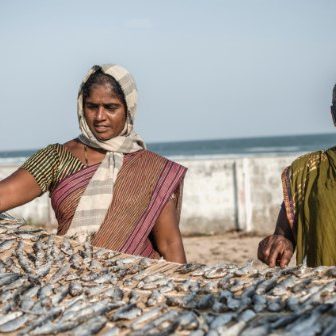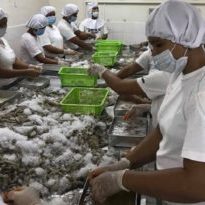Women have smaller enterprises, lower pay, and riskier work
Women have smaller enterprises, lower pay, and riskier work
Along the path from catch to consumer, gender limits the roles women play in the fishing industry.
At the industry’s front-end, an estimated 86% of workers in fishing and fish farming are men. But in post-harvest, processing and marketing, the majority of fish workers are women. During processing, women’s roles regularly involve long hours of standing and repetitive work in wet and cold environments -- conditions that contribute to a suite of health problems.
Women's roles vary with scale. Female-led fish production, processing, and marketing enterprises are usually small-scale. Men dominate leadership of large-scale fishing operations -- like industrial fishing vessels and fish farms. In seafood factories, there are few female supervisors, managers, and CEOs, but women make up the majority of factory floor workers.
Treated as a reserve army of labour in large scale enterprises, local women and migrant workers of both sexes often have the most dangerous jobs. Sea fishing ranks as one of the deadliest occupations on Earth. Working with heavy moving equipment aboard vessels heaving in the waves, ship-board accidents often include head injuries and loss of limbs. Such serious accidents typically occur far from medical help.
In fisheries and aquaculture, women and migrant workers are also the lowest paid, with little job security. This allows corporations to lower costs and increase competitiveness in global markets. Compared to men, women selling similar fish often receive lower prices for their wares. The expectation is that women are satisfied just to be employed. Male slavery in fishing has recently been under the media spotlight, but everyday exploitation of women's labour -- widespread within the industry --has received virtually no attention.
What are the workplace risks for women in fisheries? Many landing sites for boats, fish markets and factories are unsafe working environments. Here, women report facing harassment and gender-based violence from male retailers and local authorities. Some women choose to become mobile fish vendors, avoiding these areas as a strategy to ward off harassment. But this is not an ideal long-term solution.
CASE STUDY

India
In the city of Patna, women have long been involved in fish marketing, mainly as retailers. But the proportion of male versus female fish sellers is increasing, with many women leaving behind this work. A survey of women fish vendors revealed that threat to personal security is the main workplace problem.
(B) In fish markets in the city of Mumbai, women vendors are facing increased competition from men, large companies, and women. Working in inadequate processing, drying and fish handling spaces without access to clean water, they lack the political power to improve occupational conditions. The building of modern markets, offices and condominiums is squeezing fisherwomen out of their former vending sites, with newer spaces often rented out to bigger, predominantly male operators.

Bangladesh
Many women who work in shrimp processing plants lack job security. Women typically do piece work with no contracts, and no guaranteed day to day work. In factories with cold, wet conditions, women’s repetitive work also brings health and safety concerns. Respiratory problems and musculoskeletal pain are common. Fully implementing the existing labour laws required under trade agreements with the United States and European Union could improve women’s working conditions. Solutions involve putting policy into practice

Morocco
Women at processing plants peel brown shrimp (Crangon crangon). Caught in European waters, these shrimp are sent to Morocco for processing before re-export back to the Netherlands. New peeling machines have eased working conditions for handling some shrimp species, but not yet for brown shrimp. These women are fighting for better pay and working conditions. Doing arduous work for long hours, they often lack benefits like access to health care. Their low wages make the outsourced peeling profitable despite high transport costs between capture, processing and shipping back for European sales.
______________________________________________
-
GENDER-BLIND POLICIES AND DATA UNDERMINE WOMEN’S CONTRIBUTIONS
